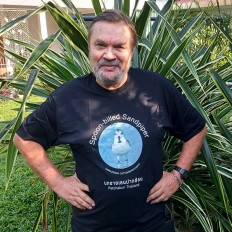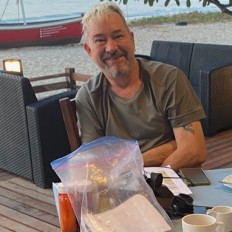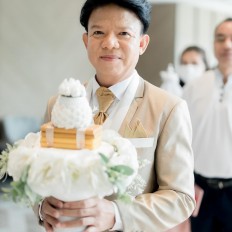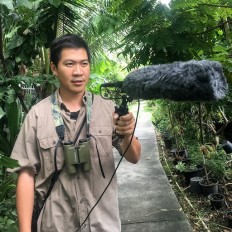November to April is the best time to visit. In March many of the birds start to assume breeding plumage and that makes it even more interesting.
Try to visit during hightide as the birds are easier to see while roosting or feeding on the saltpans and not the mud flats.
The area is filled with saltpans though many are now being turned into fish and shrimp ponds.
There is a Bird Center with parking and straight out from the center there is a permanent hide set up. This general area is normally best for Spoon-billed Sandpiper.
Walk the bunds carefully. When wet (rain or tidal water) they can be very slippery and mud will build up under your shoes. Often a pair of wellies is good to bring.
The area has a long list of birds seen but generally less diverse then Pakthale and Lampakbia further South in Phetchaburi province.
In the early morning large flocks of Plovers and Calidrises with fly about before settling.
These flocks consist primarily of Lesser (Tibetan) Sandplover, Greater Sandplover, Marsh Sandpiper, Curlew Sandpiper, Broad-billed Sandpiper, Common Redshank and Red-necked Stint. Other birds found on most visits: Common Greenshank, Black-tailed Godwith, Asian Golden Plover, Wood Sandpiper, Long-toed Stint, and SPOON-BILLED SANDPIPER!
There are other birds possible such as Asian Dowitcher, Nordmann Greenshak, Terek Sandpiper, Grey Plover, Bar-tailed Godwit, Eurasian Curlew, Whimbrel, Common Sandpiper and more!
Aside from shorebirds there are many other things around: Brown-headed Gulls, Caspian Terns, Whiskered Tern, Little and Indian Cormorants, Black-winged Stilts, Pond-Herons, Painted Storks,
Brahimy Kite, Germain's Swiftlets, Large-billed Crows, Dusky Warbler, Yellow Wagtail to name a few.
November to April is the best time to visit. In March many of the birds start to assume breeding plumage and that makes it even more interesting.
Try to visit during hightide as the birds are easier to see while roosting or feeding on the saltpans and not the mud flats.
The area is filled with saltpans though many are now being turned into fish and shrimp ponds.
Shorebirds come to roost and feed during hightide.
There is a Bird Center with parking and straight out from the center there is a permanent hide set up. This general area is normally best for Spoon-billed Sandpiper.
Walk the bunds carefully. When wet (rain or tidal water) they can be very slippery and mud will build up under your shoes. Often a pair of wellies is good to bring.
The area has a long list of birds seen but generally less diverse then Pakthale and Lampakbia further South in Phetchaburi province.
In the early morning large flocks of Plovers and Calidrises with fly about before settling.
These flocks consist primarily of Lesser (Tibetan) Sandplover, Greater Sandplover, Marsh Sandpiper, Curlew Sandpiper, Broad-billed Sandpiper, Common Redshank and Red-necked Stint. Other birds found on most visits: Common Greenshank, Black-tailed Godwith, Asian Golden Plover, Wood Sandpiper, Long-toed Stint, and SPOON-BILLED SANDPIPER!
There are other birds possible such as Asian Dowitcher, Nordmann Greenshak, Terek Sandpiper, Grey Plover, Bar-tailed Godwit, Eurasian Curlew, Whimbrel, Common Sandpiper and more!
Aside from shorebirds there are many other things around: Brown-headed Gulls, Caspian Terns, Whiskered Tern, Little and Indian Cormorants, Black-winged Stilts, Pond-Herons, Painted Storks,
Brahimy Kite, Germain's Swiftlets, Large-billed Crows, Dusky Warbler, Yellow Wagtail to name a few.
November to April is the best time to visit. In March many of the birds start to assume breeding plumage and that makes it more interesting.
Try to visit during hightide as the birds are easier to see while on the saltpans and not the mud flats.
The area is filled with saltpans though many are now being turned into fish and shrimp ponds.
Shorebirds come to roost and feed during hightide.
There is a Bird Center with parking and straight out from the center there is a permanent hide set up. This general area is normally best for Spoon-billed Sandpiper.
Walk the bunds carefully. When wet (rain or tidal water) they can be very slippery and mud will build up under your shoes. Often a pair of wellies is good to bring.
The area has a long list of birds seen but generally less diverse then Pakthale and Lampakbia further South in Phetchaburi province.
In the early morning large flocks of Plovers and Calidrises with fly about before settling.
These consist primarily of Lesser (Tibetan) Sandplover, Marsh Sandpiper, Curlew Sandpiper, Broad-billed Sandpiper, Common Redshank and Red-necked Stint. Other birds found on most visits: Common Greenshank, Black-tailed Godwith, Asian Golden Plover, Wood Sandpiper, Long-toed Stint, and SPOON-BILLED SANDPIPER!
There are other birds possible such as Asian Dowitcher, Nordmann Greenshak, Terek Sandpiper, Grey Plover, Bar-tailed Godwit, Eurasian Curlew, Whimbrel, Common Sandpiper and more!
Aside from shorebirds there are many other things around: Brown-headed Gulls, Caspian Terns, Whiskered Tern, Little and Indian Cormorants, Black-winged Stilts, Pond-Herons, Painted Storks,
Brahimy Kite, Germain's Swiftlets, Large-billed Crows, Dusky Warbler, Yellow Wagtail to name a few.
November to April is the best time to visit. In March many of the birds start to assume breeding plumage and that makes it more interesting.
Try to visit during hightide as the birds are easier to see while on the saltpans and not the mud flats.
The area is filled with saltpans though many are now being turned into fish and shrimp ponds.
Shorebirds come to roost and feed during hightide.
There is a Bird Center with parking and straight out from the center there is a permanent hide set up. This general area is normally best for Spoon-billed Sandpiper.
Walk the bunds carefully. When wet (rain or tidal water) they can be very slippery and mud will build up under your shoes. Often a pair of wellies is good to bring.
The area has a long list of birds seen but generally less diverse then Pakthale and Lampakbia further South in Phetchaburi province.
In the early morning large flocks of Plovers and Calidrises with fly about before settling.
These consist primarily of Lesser (Tibetan) Sandplover, Marsh Sandpiper, Curlew Sandpiper, Broad-billed Sandpiper, Common Redshank and Red-necked Stint. Other birds found on most visits: Common Greenshank, Black-tailed Godwith, Asian Golden Plover, Wood Sandpiper, Long-toed Stint, and SPOON-BILLED SANDPIPER!
There are other birds possible such as Asian Dowitcher, Nordmann Greenshak, Terek Sandpiper, Grey Plover, Bar-tailed Godwit, Eurasian Curlew, Whimbrel, Common Sandpiper and more!more!
Aside from shorebirds there are many other things around: Brown-headed Gulls, Caspian Terns, Whiskered Tern, Little and Indian Cormorants, Black-winged Stilts, Pond-Herons, Painted Storks,
Germain's Swiftlets, Large-billed Crows, Dusky Warbler, Yellow Wagtail to name a few.
November to April is the best time to visit. Try In March many of the birds start to assume breeding plumage and that makes it more interesting.
Try to visit during hightide as the birds are easier to see while on the saltpans and not the mud flats.
The area is filled with saltpans though many are now being turned into fish and shrimp ponds.
Shorebirds come to roost and feed during hightide.
There is a Bird Center with parking and straight out from the center there is a permanent hide set up. This general area is normally best for Spoon-billed Sandpiper.
Walk the bunds carefully. When wet (rain or tidal water) they can be very slippery and mud will build up under your shoes. Often a pair of wellies is good to bring.
The area has a long list of birds seen but generally less diverse then Pakthale and Lampakbia further South in Phetchaburi province.
In the early morning large flocks of Plovers and Calidrises with fly about before settling.
These consist primarily of Lesser (Tibetan) Sandplover, Marsh Sandpiper, Curlew Sandpiper, Broad-billed Sandpiper, Common Redshank and Red-necked Stint. Other birds found on most visits: Common Greenshank, Black-tailed Godwith, Asian Golden Plover, Wood Sandpiper, Long-toed Stint, and SPOON-BILLED SANDPIPER!
There are other birds possible such as Asian Dowitcher, Nordmann Greenshak, Terek Sandpiper, Grey Plover, Bar-tailed Godwit, Eurasian Curlew, Whimbrel and Whimbrel, Common Sandpiper.Sandpiper and more!
November to April is the best time to visit. Try to visit during hightide as the birds are easier to see while on the saltpans and not the mud flats.
The area is filled with saltpans though many are now being turned into fish and shrimp ponds.
Shorebirds come to roost and feed during hightide.
There is a Bird Center with parking and straight out from the center there is a permanent hide set up. This general area is normally best for Spoon-billed Sandpiper.
Walk the bunds carefully. When wet (rain or tidal water) they can be very slippery and mud will build up under your shoes. Often a pair of wellies is good to bring.
The area has a long list of birds seen but generally less diverse then Pakthale and Lampakbia further South in Phetchaburi province.
In the early morning large flocks of Plovers and Calidrises with fly about before settling.
These consist primarily of Lesser (Tibetan) Sandplover, Marsh Sandpiper, Curlew Sandpiper, Broad-billed Sandpiper, Common Redshank and Red-necked Stint. Other birds found on most visits: Common Greenshank, Black-tailed Godwith, Asian Golden Plover, Wood Sandpiper, Long-toed Stint, and SPOON-BILLED SANDPIPER!
There are other birds possible such as Asian Dowitcher, Nordmann Greenshak, Terek Sandpiper, Grey Plover, Bar-tailed Godwit, Eurasian Curlew, Whimbrel and Common Sandpiper.





